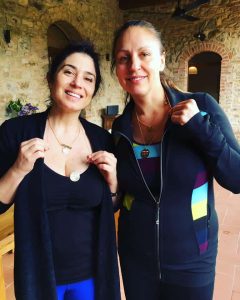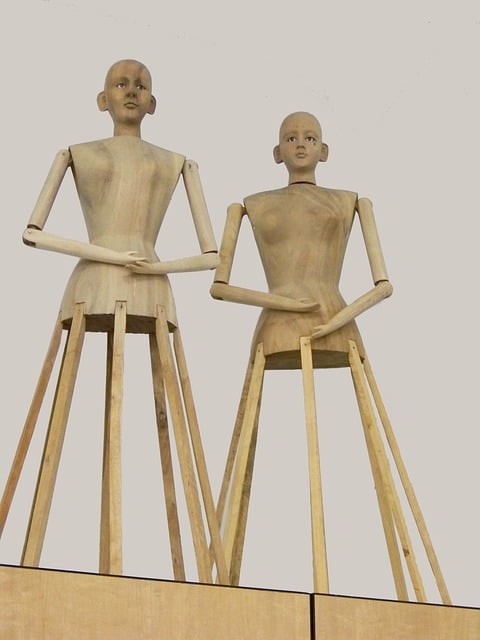By Jennifer D Munro
“Chanel freed women, and I empowered them.” –Yves Saint Laurent
* * *
I advanced efficiently through Yves Saint Laurent’s explosion of color, crammed into the Seattle Art Museum like Auntie Mame’s walk-in closet: A green Pop Art dress with a bold pink heart over the entire bodice. A hip-length vest made of orange raffia fringe. An ice-blue bow-bustle big enough to cover even my derriere, though nothing in this exhibit would fit me except the mustard-yellow cape of the type worn by heroines flinging themselves off cliffs, melancholy about looking seasick in that color. A Chinese-red jacket. “Lichen green and moss green chiffon” (from the gallery guide, as if I could tell the difference between lichen and moss greens). And the grids of white and primary colors and bold black lines of the iconic Mondrian (I assumed this was a dead artist and not a Star Trek alien or type of porch column) cocktail dress plastered on Seattle billboards to advertise this unconventional art show.
I’d had no desire to see this haute couture collection, but my friend Irene, equally unconcerned with style—her go-to is Value Village, mine is Sears—had surprised me by urging me to go. Shortly after the U.S. presidential election, we’d joined a peaceable demonstration at the lake we’d spent nearly 30 years walking around together in sweatpants and untinted lip balm. Irene’s hair has been white for almost as long as I’ve known her, though she’s not much older than I. Irene had attended the fashion designer’s exhibit right after the election, because, she said, “I needed to be surrounded by beauty.”
Irene’s grandfather fled Nazi Germany with her young mother and other family members the day before he was to report to the Gestapo; any family left behind, including his parents, were never heard from again. Her father’s family fled Communist Russia to escape political persecution when he was an infant. Her parents met in Shanghai, which immigrants could buy their way into, at a refugee camp: the U.S. was not then accepting refugees.
I hadn’t been to a protest since a NARAL march I joined around the time I met Irene. At the lakeside rally, thousands of protesters linked hands around the entire three-mile perimeter in a show of love and solidarity. I’d never held hands with Irene before. We’d simply walked side by side in a circle since The Bangles and Debbie Gibson were at the top of the charts.
If finding myself at a fashion show two weeks later was any sign, the world had indeed shifted. I thought I lingered sufficiently at each costume, yet I’d passed what I dubbed the Marcia! Marcia! Marcia! Brady Collection and was onto the Genie Stuff while my friend Emily still examined the sailor-sweater dress way back in the Beatnik Party Room.
I pulled up short at several groupings of mannequins in the very back corner. They had a startled look about them, like flustered, half-clothed beauty contestants when the pageant’s owner crashes the dressing room. They were packed tightly together, detained in their cordoned-off boxcar stalls, unlike the generously spread-out mannequins in the rest of the exhibit. They clustered together in a state of dishabille, as if they’d been commanded to leave before they had a full chance to dress or pack. Identical white material, though of different patterns, draped each one, with abundant mannequin skin showing through gapping, unfinished seams. Bald, emaciated, crammed together in undifferentiated bland outfits, their forlorn pride was disquieting amidst the vibrant finery surrounding them.
I felt drawn to these hapless women in a way I can’t usually relate to models, never once having seen my hipbones since my pelvis presumably began jutting out in puberty nor having any space between my thighs when I stand with my legs together.
These were toile, I learned from the exhibit placard: a preliminary garment made of white cotton that goes through three or four fittings. Only once the pattern has been tested are the fabrics, colors, and ornaments brought in to replace it, completing the outfit.
* * *
Yves Saint Laurent wasn’t just another designer. He was an icon who forever changed the way women dress. Saint Laurent put women in pants. His elegant designs let women swagger like men, giving them the sartorial equivalent of chutzpah. Without Saint Laurent…how would our mind’s eye see the authoritative ease expressed by Nancy Pelosi and Hillary Clinton?
—Robin Givhan, excerpted from Yves Saint Laurent’s Washington Post obituary, 2008
* * *
“I need to start by apologizing,” Chef Jeanine Garcia began our holiday cookie decorating class a week later. “I had the class supplies all ready to go yesterday, but my eight-year-old niece got into them and apparently took out all of the food dye. So we have no colors for class and will have to learn and practice with white frosting only.”
I’d recently taken a cupcake-decorating class with Chef Garcia. She’d neatly laid out a complicated array of supplies at each seat for both classes well before class members arrived, so I knew this oversight was rare for her. I wasn’t bothered, but she continued to express regret about the lack of color.
First we learned to squirt shell borders of white frosting onto white parchment paper. Shell borders are difficult to get quite right. They smear or gap or ooze into the next shell. Turns out I don’t much like borders of any kind and would rather start in the middle.
We learned rosettes and stars. Then we reached rosebuds, which required the most practice and skill. I’d failed at rosebuds in cupcake class and didn’t even try this time around. I leaned toward unchallenging patterns and complacency.
“I love working with color,” Chef Garcia lamented once again as we were given free rein to move on from the parchment paper and decorate our sugar cookies at will.
My neighbor to the left was my same left-hand neighbor as for the cupcake class, and I’d been happy to see a familiar face amidst the once again all-female class. Hai (fittingly pronounced Ha) continually cracked me up with her no-holds-barred approach to decorating. While I was hesitant and whiny about not easily getting things right though I’d never done this before, Hai tended to finish her lavish if inexpert decorating before Chef Garcia finished with instructions. I was out of my comfort zone with this inexplicable foray into pastry decorating: I’m not visual when it comes to creativity. Hai egged me on and inspired me with her intrepid style. No fear of failing. No worrying about perfection on her first try. Just balls-to-the-wall frosting. Laughter easily surmounted our slight language barrier—Hai was older than I and had emigrated from Vietnam long ago—and we often looked over each other’s elbows to see what the other was up to.
I “flooded” my white cookie with thin white frosting and then dolloped stiffer white rosettes on top. The layered effect of different consistencies was interesting. Still, the white-on-white designs seemed lacking. I piped simple icicles onto the cookies, leaving lots of cookie exposed. I preferred these, rather than trying to cover something up.
I improvised a Santa face, with white hair and beard. This was my least favorite cookie, and I ate him.
No matter how different our cupcakes and cookies looked, they all tasted exactly the same.
I took home cookies of snow and winter and icicles. I bought no Christmas tree that season. I felt not celebratory, but despondent over history threatening to repeat itself. Eventually we hung a single string of white lights across our deck.
In January, on Inauguration Day, Hillary Clinton—the first female candidate to be nominated for president by a major U.S. political party—strode proudly in her suffragette-white pantsuit (a three-piece Ralph Lauren), her husband taking her elbow. But what I felt was anemic, unstitched—my insides pulled out like kapok.
* * *
Saint Laurent came along and gave [women] power. Power, as we know, is held by men; so by taking inspiration from the male wardrobe…Saint Laurent transmitted that power to them. More than a lot of other people, he fought publicly for equality between the sexes and for recognition of the modern woman, not as an object but as a confident participant in the life of her times.
–Pierre Bergé (onetime life partner and longtime business partner of Yves Saint Laurent)
* * *
A line of white men in white shirts and suitcoats stood behind a seated white man as he signed an executive order as a step in ending women’s reproductive rights.
One week later, on International Holocaust Day, the seated white man signed another in a series of executive orders: the so-called “Muslim ban,” banning immigration from certain predominantly Muslim countries—people of the wrong faith, the wrong color. Even immigrants and travelers with clearance were being detained unlawfully at airports across the country.
If I tried to pronounce toile, you’d think I was hawking up an owl pellet. Toile is etymologically related to toilet.
Toilets are white, until continual hard-water flushing stains them an ugly orange at the brim—tough to get rid of, but possible with enough will, work, and persistence.
Saint Laurent was the first fashion designer to use black models on the runway. He understood that white was not the whole picture. As with the Mondrian dress, white was part of the full palette of color.
Saint Laurent ripped out our notions of gender. With art, he altered the prototype for equality. He put women in pants—the better to march in. Given my orthopedic inserts and the hip joint I blew out while making a fruitcake five days before the historic Women’s March, I’ll hobble metaphorically rather than stride. Stumble though I will, I must diverge from the same sheltered path and follow the hems of the women who marched in skirts before me, altering the runway of history.
This will be no piece of cake, this smudging the border of my comfort zone, and it might not be pretty, but so too will I make a fisted rosebud. Imperfection does not matter; making an attempt does.
I am a writer, facing the blank page. But there is no tabula rasa, no clean slate. The stains of history are too blatant, like me in an ecru sweater after a spaghetti dinner with red wine.
The patterns are already clear.


